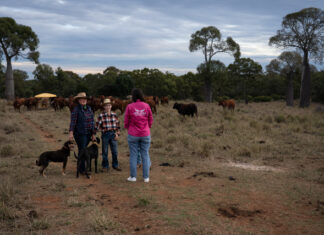Q: What weighs 10 times as much as the world’s tallest building?
A: The amount of fertiliser used by Aussie farmers each year.
Yep, around five million tonnes of fertiliser is applied to agriculture land across the continent annually.
And, while cattle and sheep account for most of our sector’s greenhouse gas emissions, fertiliser, mainly nitrogen fertiliser, is also a major contributor.
Once applied to agricultural land, this type of fertiliser can lead to the release of nitrous oxide, an active greenhouse gas that is particularly good at trapping heat in the atmosphere. In fact, nitrous oxide is 265 times more potent than carbon dioxide when it comes to global warming, according to the CSIRO. And it is responsible for about 15 per cent of emissions in Australian agriculture.
It’s not only the use of fertiliser that is emissions-intensive; the production side is also culpable. The manufacture of nitrogen fertilisers requires high temperatures, typically generated by fossil fuels.
Already, we are seeing several countries looking to place limits on nitrogen fertiliser use in agriculture, including Canada, New Zealand and the Netherlands.
But reducing fertiliser generated emissions is not as simple as cutting down on usage.
Fertilisers are essential for providing nutrients, particularly nitrogen, phosphorus, and potassium, for plants, in turn reducing soil erosion.
With pressure to remain highly productive while also reducing reliance on chemical fertilisers, the transition from synthetic fertilisers to more environmentally friendly alternatives is well underway in Australia. A host of innovative, natural yet effective solutions are emerging.
Our current Grains Research and Development Corporation (GRDC) supported GroundUp accelerator program includes a host of innovators who have developed organic solutions that can deliver improved soil and crops.
For example, there’s Metagen, with its DIGESTOR product, reducing reliance on nitrogen and phosphorous inputs by significantly improving the efficiency of these resources already present in the soil. It specifically stimulates indigenous soil biology, increasing the activity of microbes responsible for nitrogen fixation, cycling and phosphorus solubilisation.
UK-based innovator Messium has developed a nitrogen concentration estimation system that delivers fertiliser savings. Its satellite Nitrogen Estimator delivers valuable insights on nitrogen concentration levels in wheat, enabling farmers to make substantial savings in annual fertiliser costs.
Another GroundUp participant, MADE, offers locally produced biofertilisers and biofuels that reduce farmers’ reliance on synthetic fertilisers while improving yields and reducing costs through improved soil health. Its high-quality digestate-based biofertilisers are tailored to plant needs, soil and climate conditions, optimising nutrient management by rebalancing the soil microbiome to improve plant health and yields, build soil health and reduce disease pressures.
I can’t wait to see how these innovators’ solutions progress throughout the accelerator program, which is focused on fast-tracking these and a host of other incredible solutions for the grains sector.
* Thomas Hall is the Director of the Agtech and Logistics Hub, Australia’s home of digital agriculture.







